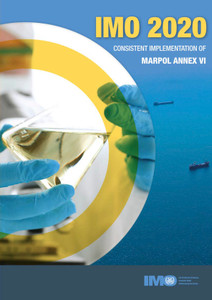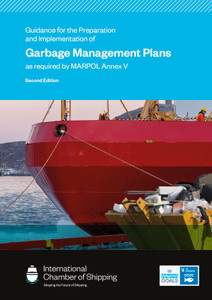
MARPOL Annex VI and NTC 2008 with Guidelines for Implementation - 2023 Edition
MARPOL Annex VI, Regulations for the prevention of air pollution from ships, covers the requirements in respect of both control of emissions of air pollutants from ships (chapter 3) and carbon intensity of international shipping (chapter 4). The requirements for control of nitrogen oxides (NOx) emissions, given by chapter 3, are supplemented by the mandatory NOx Technical Code 2008, which covers the testing, survey and certification of marine diesel engines.
This fifth edition of the consolidated texts of MARPOL Annex VI and the NOx Technical Code 2008 includes all amendments through to those adopted at MEPC 76 in June 2021, in particular those on the IMO short-term greenhouse gas (GHG) reduction measures (EEXI, CII and enhanced SEEMP).
Also contained are the current versions of the Guidelines and other information relevant to the application of MARPOL Annex VI and the NOx Technical Code 2008. These include all those related to:
- exhaust gas treatment systems and measures for reduction of NOx and SOx emissions from ships;
- improvement of energy efficiency to reduce GHG emissions from ships, related to chapter 4 of MARPOL Annex VI; and
- sulphur content of fuel oil used by ships.
This publication is intended to be of use to maritime administrations, recognized organizations, shipping companies, classification societies, educational institutes, shipbuilders and equipment manufacturers together with others with an interest in the prevention of air pollution from ships and in the technical and operational measures to improve the energy efficiency of ships.
Foreword
MARPOL Annex VI Regulations for the prevention of air pollution from ships Resolution MEPC.176(58)
Amendments to the Annex of the Protocol of 1997 to amend the International Convention for the Prevention of Pollution from Ships, 1973, as modified by the Protocol of 1978 relating thereto (Revised MARPOL Annex VI)
Chapter 1 – General
Regulation 1 Application
Regulation 2 Definitions
Regulation 3 Exceptions and exemptions
Regulation 4 Equivalents
Chapter 2 – Survey, certification and means of control Regulation 5 Surveys
Regulation 6 Issue or endorsement of Certificates and Statements of Compliance related to fuel oil consumption reporting and operational carbon intensity rating
Regulation 7 Issue of a Certificate by another Party
Regulation 8 Form of Certificates and Statements of Compliance related to fuel oil consumption reporting and operational carbon intensity rating
Regulation 9 Duration and validity of Certificates and Statements of Compliance related to fuel oil consumption reporting and operational carbon intensity rating
Regulation 10 Port State control on operational requirements
Regulation 11 Detection of violations and enforcement
Chapter 3 – Requirements for control of emissions from ships Regulation 12 Ozone-depleting substances
Regulation 13 Nitrogen oxides (NOx )
Regulation 14 Sulphur oxides (SOx) and particulate matter
Regulation 15 Volatile organic compounds
Regulation 16 Shipboard incineration
Regulation 17 Reception facilities
Regulation 18 Fuel oil availability and quality
Chapter 4 – Regulations on the carbon intensity of international shipping
Regulation 19 Application
Regulation 20 Goal
Regulation 21 Functional requirements
Regulation 22 Attained Energy Efficiency Design Index (attained EEDI)
Regulation 23 Attained Energy Efficiency Existing Ship Index (attained EEXI)
Regulation 24 Required EEDI
Regulation 25 Required EEXI
Regulation 26 Ship Energy Efficiency Management Plan (SEEMP)
Regulation 27 Collection and reporting of ship fuel oil consumption data
Regulation 28 Operational carbon intensity
Regulation 29 Promotion of technical cooperation and transfer of technology relating to the improvement of energy efficiency of ships
Chapter 5 – Verification of compliance with the provisions of this Annex
Regulation 30 Application
Regulation 31 Verification of compliance
Appendices to Annex VI Appendix I Form of International Air Pollution Prevention (IAPP) Certificate (regulation 8)
Appendix II Test cycles and weighting factors (regulation 13)
Appendix III Criteria and procedures for the designation of emission control areas (regulations 13.6 and 14.3)
Appendix IV Type approval and operating limits for shipboard incinerators (regulation 16)
Appendix V Information to be included in the bunker delivery note (regulation 18.5)
Appendix VI Verification procedures for a MARPOL Annex VI fuel oil sample (regulation 18.8.2 or regulation 14.8)
Appendix VII Emission control areas (regulations 13.6 and 14.3)
Appendix VIII Form of International Energy Efficiency (IEE) Certificate (regulation 8.2)
Appendix IX Information to be submitted to the IMO Ship Fuel Oil Consumption Database (regulation 27)
Appendix X Form of Statement of Compliance – Fuel oil consumption reporting and operational carbon intensity rating (regulation 8.3)
Appendix XI Form of Exemption Certificate for UNSP Barges (regulation 8.4)
Unified interpretations of Annex VI
IMO
As a specialised agency of the United Nations, IMO is the global standard-setting authority for the safety, security and environmental performance of international shipping. Its main role is to create a regulatory framework for the shipping industry that is fair and effective, universally adopted and universally implemented.
In other words, its role is to create a level playing-field so that ship operators cannot address their financial issues by simply cutting corners and compromising on safety, security and environmental performance. This approach also encourages innovation and efficiency.
Shipping is a truly international industry, and it can only operate effectively if the regulations and standards are themselves agreed, adopted and implemented on an international basis. And IMO is the forum at which this process takes place.
- Number of Pages:
- 438
- Published Date:
- August 2023
- Book Height:
- 0 mm
- Book Width:
- 0 mm
- Author:
International Maritime Organisation
- Publication Date:
- August 2023





